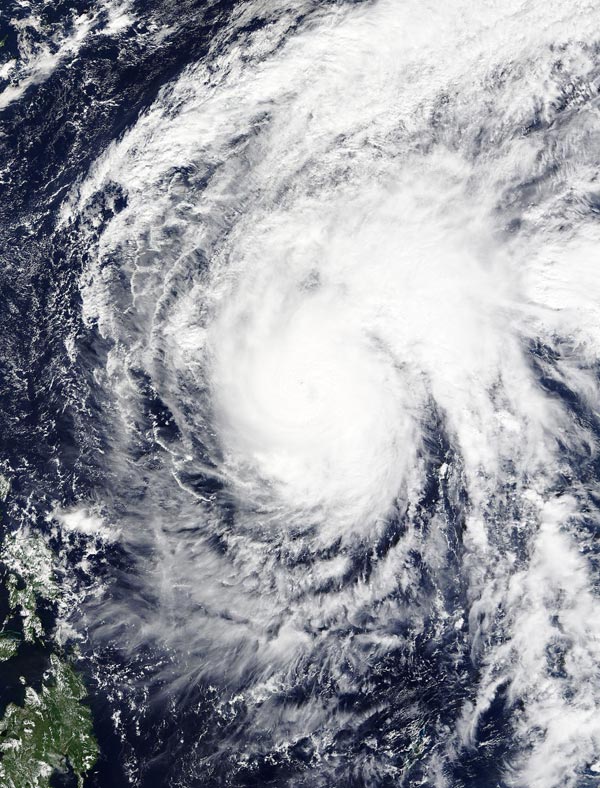NASA's Terra satellite sees Typhoon In-fa stretching

On Nov. 23 at 02:00 UTC the MODIS instrument aboard NASA's Terra satellite captured this image of Typhoon In-fa in the Pacific Ocean. Credits: NASA Goddard MODIS Rapid Response Team
On Nov. 23 at 02:00 UTC (Nov. 22 at 9 p.m. EST) the Moderate Resolution Imaging Spectroradiometer or MODIS instrument aboard NASA's Terra satellite captured an image of Typhoon In-fa in the Pacific Ocean.
In-fa's cloud-filled eye was surrounded by powerful thunderstorms. A large band of thunderstorms were wrapping into the low-level center in the northeastern quadrant, and stretching east.
Forecasters at the Joint Typhoon Warning Center noted that the system continues to be elongated to the northeast along the leading edge of an approaching mid-Latitude trough (elongated area of low pressure).
On Nov. 23 at 1500 UTC (10 a.m. EST), Typhoon In-fa had maximum sustained winds near 90 knots (103.6 mph/ 166.7 kph). Typhoon-force winds only extend nautical 25 miles (28.7 miles/46.3 km) from the center.
It was centered near 16.9 north latitude and 131.3 east longitude, about 734 nautical miles (844.7 miles/1,359 km) southwest of Iwo To, Japan.
In-fa was moving to the north-northwest at 4 knots (4.6 mph/7.4 kph) and is expected to curve to the northeast.
Environmental conditions are expected to continue to deteriorate as vertical wind shear rapidly increases due to the strong westerly winds from the approaching trough.
The Joint Typhoon Warning Center expects In-fa to weaken over the next couple of days and become an extra-tropical storm.
In-fa is forecast to approach the island of Iwo To, Japan on Nov. 26 and move in a northeasterly direction.
Media Contact
All latest news from the category: Earth Sciences
Earth Sciences (also referred to as Geosciences), which deals with basic issues surrounding our planet, plays a vital role in the area of energy and raw materials supply.
Earth Sciences comprises subjects such as geology, geography, geological informatics, paleontology, mineralogy, petrography, crystallography, geophysics, geodesy, glaciology, cartography, photogrammetry, meteorology and seismology, early-warning systems, earthquake research and polar research.
Newest articles

Bringing bio-inspired robots to life
Nebraska researcher Eric Markvicka gets NSF CAREER Award to pursue manufacture of novel materials for soft robotics and stretchable electronics. Engineers are increasingly eager to develop robots that mimic the…

Bella moths use poison to attract mates
Scientists are closer to finding out how. Pyrrolizidine alkaloids are as bitter and toxic as they are hard to pronounce. They’re produced by several different types of plants and are…

AI tool creates ‘synthetic’ images of cells
…for enhanced microscopy analysis. Observing individual cells through microscopes can reveal a range of important cell biological phenomena that frequently play a role in human diseases, but the process of…





















